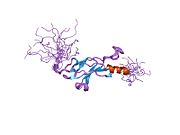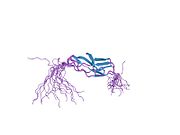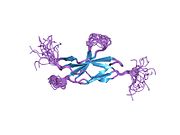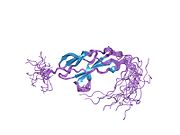FNDC3A
Protein-coding gene in the species Homo sapiens
| FNDC3A | |||||||||||||||||||||||||||||||||||||||||||||||||||
|---|---|---|---|---|---|---|---|---|---|---|---|---|---|---|---|---|---|---|---|---|---|---|---|---|---|---|---|---|---|---|---|---|---|---|---|---|---|---|---|---|---|---|---|---|---|---|---|---|---|---|---|
 | |||||||||||||||||||||||||||||||||||||||||||||||||||
| |||||||||||||||||||||||||||||||||||||||||||||||||||
| Identifiers | |||||||||||||||||||||||||||||||||||||||||||||||||||
| Aliases | FNDC3A, FNDC3, HUGO, bA203I16.1, bA203I16.5, fibronectin type III domain containing 3A | ||||||||||||||||||||||||||||||||||||||||||||||||||
| External IDs | OMIM: 615794; MGI: 1196463; HomoloGene: 8952; GeneCards: FNDC3A; OMA:FNDC3A - orthologs | ||||||||||||||||||||||||||||||||||||||||||||||||||
| |||||||||||||||||||||||||||||||||||||||||||||||||||
| |||||||||||||||||||||||||||||||||||||||||||||||||||
| |||||||||||||||||||||||||||||||||||||||||||||||||||
| |||||||||||||||||||||||||||||||||||||||||||||||||||
| |||||||||||||||||||||||||||||||||||||||||||||||||||
| Wikidata | |||||||||||||||||||||||||||||||||||||||||||||||||||
| |||||||||||||||||||||||||||||||||||||||||||||||||||
Fibronectin type-III domain-containing protein 3a is a protein that in humans is encoded by the FNDC3A gene.[5]
References
- ^ a b c GRCh38: Ensembl release 89: ENSG00000102531 – Ensembl, May 2017
- ^ a b c GRCm38: Ensembl release 89: ENSMUSG00000033487 – Ensembl, May 2017
- ^ "Human PubMed Reference:". National Center for Biotechnology Information, U.S. National Library of Medicine.
- ^ "Mouse PubMed Reference:". National Center for Biotechnology Information, U.S. National Library of Medicine.
- ^ "Entrez Gene: FNDC3A fibronectin type III domain containing 3A".
Further reading
- Nakajima D, Okazaki N, Yamakawa H, et al. (2003). "Construction of expression-ready cDNA clones for KIAA genes: manual curation of 330 KIAA cDNA clones". DNA Res. 9 (3): 99–106. doi:10.1093/dnares/9.3.99. PMID 12168954.
- Carrouel F, Couble ML, Vanbelle C, et al. (2008). "HUGO (FNDC3A): a new gene overexpressed in human odontoblasts". J. Dent. Res. 87 (2): 131–6. doi:10.1177/154405910808700209. PMID 18218838. S2CID 27513925.
- Olsen JV, Blagoev B, Gnad F, et al. (2006). "Global, in vivo, and site-specific phosphorylation dynamics in signaling networks". Cell. 127 (3): 635–48. doi:10.1016/j.cell.2006.09.026. PMID 17081983.
- Gerhard DS, Wagner L, Feingold EA, et al. (2004). "The status, quality, and expansion of the NIH full-length cDNA project: the Mammalian Gene Collection (MGC)". Genome Res. 14 (10B): 2121–7. doi:10.1101/gr.2596504. PMC 528928. PMID 15489334.
- Dunham A, Matthews LH, Burton J, et al. (2004). "The DNA sequence and analysis of human chromosome 13". Nature. 428 (6982): 522–8. Bibcode:2004Natur.428..522D. doi:10.1038/nature02379. PMC 2665288. PMID 15057823.
- Ota T, Suzuki Y, Nishikawa T, et al. (2004). "Complete sequencing and characterization of 21,243 full-length human cDNAs". Nat. Genet. 36 (1): 40–5. doi:10.1038/ng1285. PMID 14702039.
- Strausberg RL, Feingold EA, Grouse LH, et al. (2003). "Generation and initial analysis of more than 15,000 full-length human and mouse cDNA sequences". Proc. Natl. Acad. Sci. U.S.A. 99 (26): 16899–903. Bibcode:2002PNAS...9916899M. doi:10.1073/pnas.242603899. PMC 139241. PMID 12477932.
- Nagase T, Ishikawa K, Suyama M, et al. (1999). "Prediction of the coding sequences of unidentified human genes. XIII. The complete sequences of 100 new cDNA clones from brain which code for large proteins in vitro". DNA Res. 6 (1): 63–70. doi:10.1093/dnares/6.1.63. PMID 10231032.
- Bonaldo MF, Lennon G, Soares MB (1997). "Normalization and subtraction: two approaches to facilitate gene discovery". Genome Res. 6 (9): 791–806. doi:10.1101/gr.6.9.791. PMID 8889548.
- v
- t
- e
PDB gallery
-
 1wk0: Solution structure of Fibronectin type III domain derived from human KIAA0970 protein
1wk0: Solution structure of Fibronectin type III domain derived from human KIAA0970 protein -
 1x3d: Solution structure of the fibronectin type-III domain of human fibronectin type-III domain containing protein 3a
1x3d: Solution structure of the fibronectin type-III domain of human fibronectin type-III domain containing protein 3a -
 1x4x: Solution structure of the 6th fibronectin type III domain from human fibronectin type III domain containing protein 3
1x4x: Solution structure of the 6th fibronectin type III domain from human fibronectin type III domain containing protein 3 -
 1x5x: Solution structure of the fibronectin type-III domain of human fibronectin type III domain containing protein 3
1x5x: Solution structure of the fibronectin type-III domain of human fibronectin type III domain containing protein 3 -
 2crm: Solution structure of the fourth FNIII domain of human
2crm: Solution structure of the fourth FNIII domain of human -
 2crz: Solution structure of the fifth FNIII domain of human fibronectin type III domain containing protein 3a
2crz: Solution structure of the fifth FNIII domain of human fibronectin type III domain containing protein 3a
 | This article on a gene on human chromosome 13 is a stub. You can help Wikipedia by expanding it. |
- v
- t
- e
























